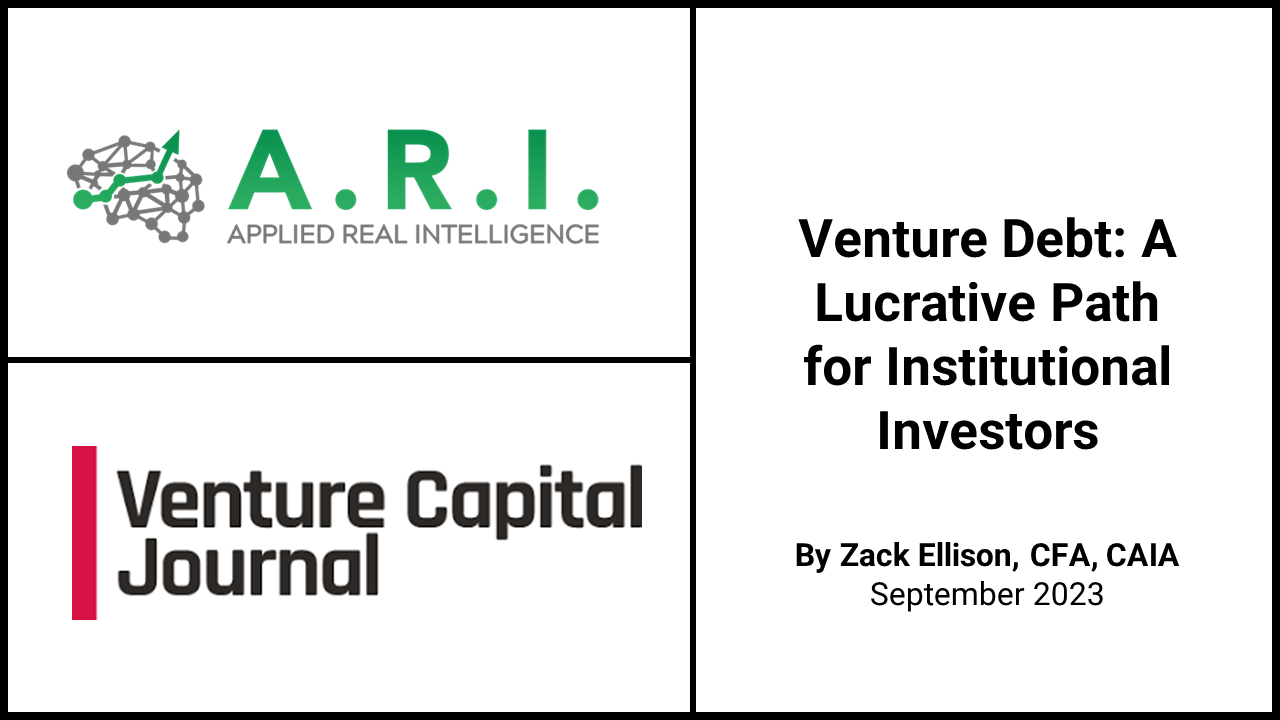
Venture Debt: A Lucrative Path for Institutional Investors
Compounded at 15% per year, an investment in venture debt over 10 years produces a 4x on invested capital, writes Zack Ellison of Applied Real Intelligence.
Venture equity is the primary asset class private market investors use to access the best early-stage companies. But venture debt is emerging as an attractive complement, providing access to the same high-growth companies but with significantly less risky exposure to “innovation” as an asset class.
Venture debt’s visibility rose exponentially with the failure of Silicon Valley Bank in March. The regional bank was the biggest player in the venture debt business, providing more than half of all U.S. venture loans during the past 20 years. While SVB’s venture debt portfolio remained unscathed, the bank’s collapse has left a massive void in the venture ecosystem.
Non-bank lenders now have an opportunity to fill the gap as demand for venture debt surges while supply is constrained. If history is a guide, non-bank venture lenders will thrive as regional banks reduce their credit offerings over the next stage of the economic cycle, just as private direct lenders proliferated after the Global Financial Crisis.
The Basics
In its current form, venture debt has been around for more than 20 years, but even now, many institutional investors are unaware that it can help supercharge their portfolio returns.
In simple terms, venture debt consists of senior secured loans combined with equity warrants (usually 5 percent to 10 percent of the loan amount), made to venture-backed startups that have reached a growth or expansion stage.
These loans are typically made to Series B through Series E companies that are producing between $10 million and $150 million (or more) per year in revenue and can service debt payments. Founders love venture debt because it provides a cheaper, minimally dilutive complement to equity financing, with transactions that can be executed in as little as four to six weeks.
The loans are typically short maturity (two to four years), secured by all assets of the borrower, have a floating rate coupon and produce high income (prime rate plus a credit spread of 400 to 800 basis points) from the outset, so there is no J-curve effect.
High Returns, Low Risk
Although the upside is lower than venture equity, the safety and stability of the loan combined with the equity participation is nonetheless extremely attractive. My analysis of publicly available data from five business development companies that specialize in venture debt demonstrates that the loans have historically yielded mid-teens returns with loss rates of less than 0.50 percent per year. (I based my analysis on the public SEC filings of Hercules Capital, TriplePoint Venture Growth BDC, Horizon Technology Finance Corp, Runway Growth Finance, and Trinity Capital.)
Moreover, data from the Cliffwater Direct Lending Index demonstrates that the yield on 641 venture loans worth $7.4 billion held by BDCs yields 14.48 percent, representing a yield pickup of approximately 3.25 percent versus the 11.24 percent average yield on $103 billion of senior middle market loans. (The CDLI seeks to measure the unlevered, gross-of-fees performance of US middle market corporate loans, as represented by the underlying assets of business development companies, including publicly traded and unlisted BDCs, subject to certain eligibility criteria.)
Compounded at 15 percent per year, an investment in venture debt over 10 years produces a 4x multiple on invested capital. When the equity kickers are included, compounded returns can reach 20 percent per year, producing a 6.2x MOIC in 10 years – far in excess of what one would hope to attain even in the most highly regarded private equity and venture capital funds, or a 10-year public stock bull market. For instance, in the decade from year-end 2012 to year-end 2022, the S&P 500 increased just 2.7x from 1,426 to 3,839 in one of the most powerful bull markets in history.
The high risk-adjusted returns and portfolio diversification benefits that venture debt has historically produced have led to a surge in its acceptance and popularity with institutional investors. In fact, annual venture lending in the US has increased more than 8x since 2010, from a little under $4 billion then to over $32 billion in each of the past two years, according to the PitchBook-NVCA Venture Monitor, Q2 2023.
Smart Money is All-In
Institutional powerhouses like BlackRock and Blackstone are leading the charge into venture debt, with BlackRock’s acquisition of Kreos Capital highlighting the strategy’s attractiveness for income generation, low volatility, and portfolio diversification. Notably, early Facebook investor and tech luminary Peter Thiel entered the venture debt arena last December, investing $250 million in a first-time fund in Texas, according to a Bloomberg report. Similarly, private market giants such as KKR and Bain Capital are considering expanding their venture debt programs, possibly through acquisition, as The Information has reported. These moves underscore a broader trend within the investment landscape, where major players are increasingly embracing venture debt as a strategic avenue for robust returns and diversification.
Venture debt is not just an investment option. It is a strategic imperative in today’s competitive financial landscape.
Zack Ellison is the founder and managing partner of Applied Real Intelligence and CIO of the A.R.I. Senior Secured Growth Credit Fund. Send comments or questions to zellison@arivc.com and visit A.R.I.’s website at www.arivc.com.